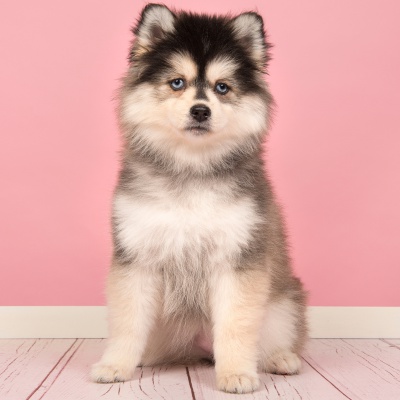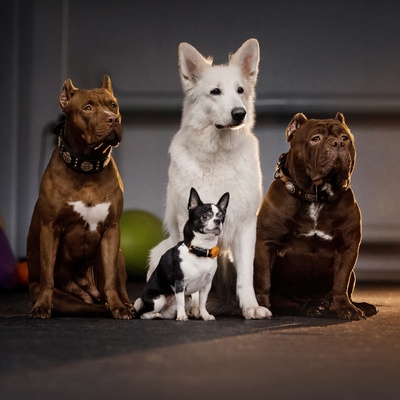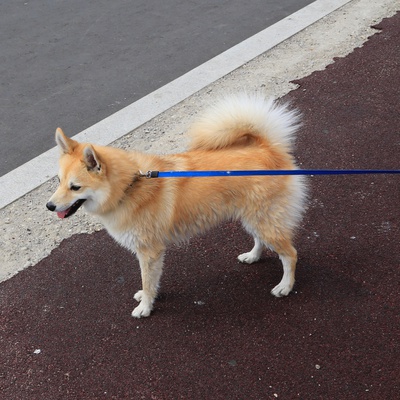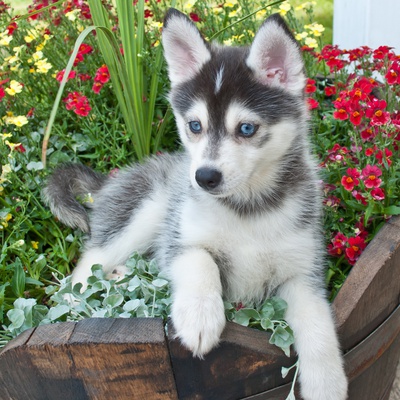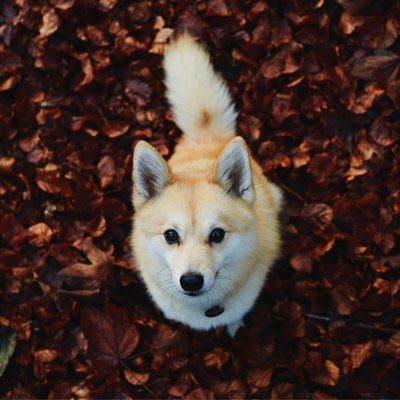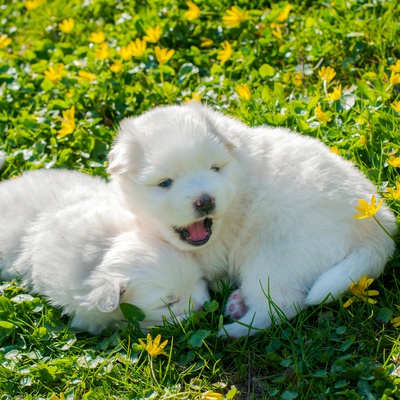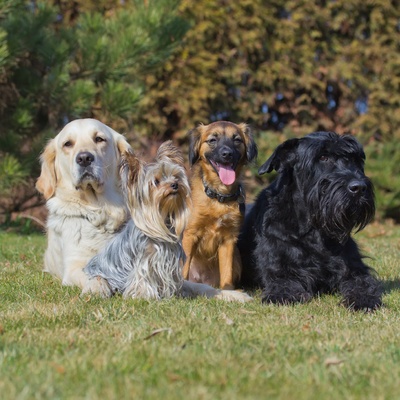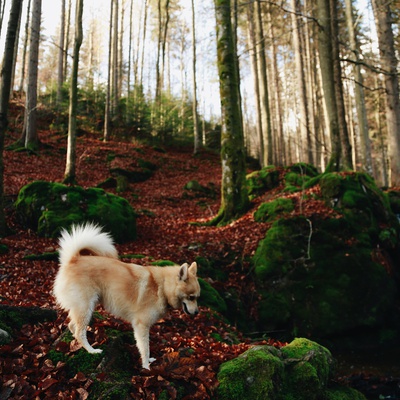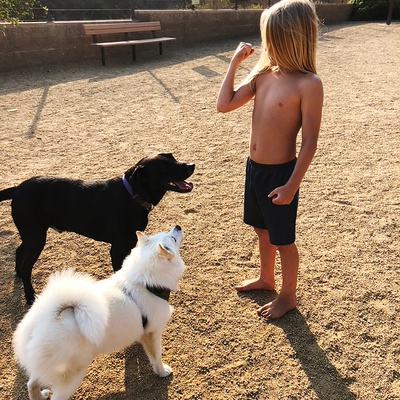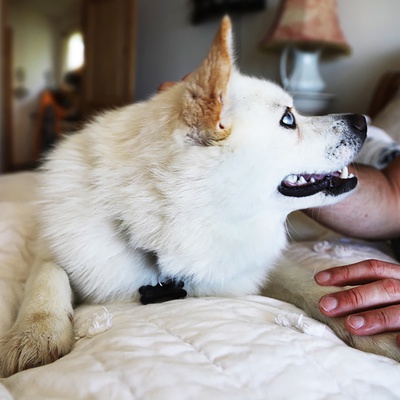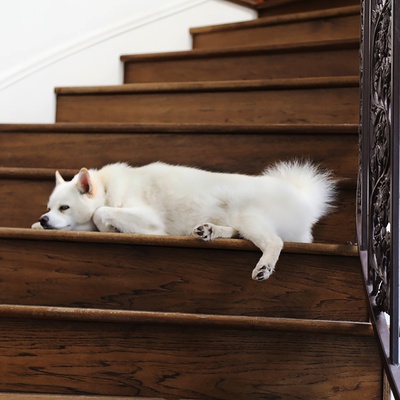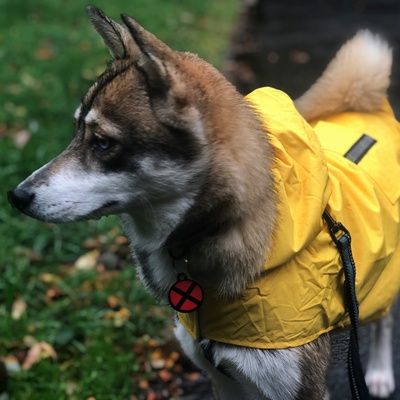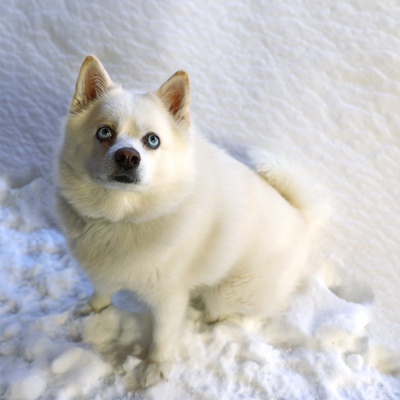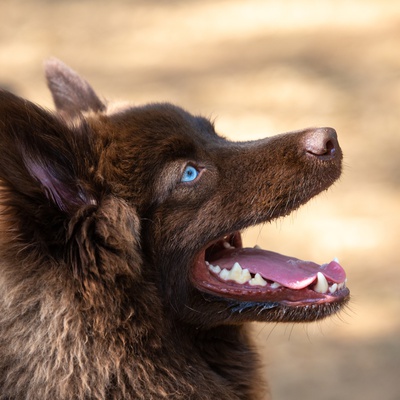Introducing the Pomsky
Discover all there is to know about the Pomsky: its characteristics, behavior, training, and its cost.
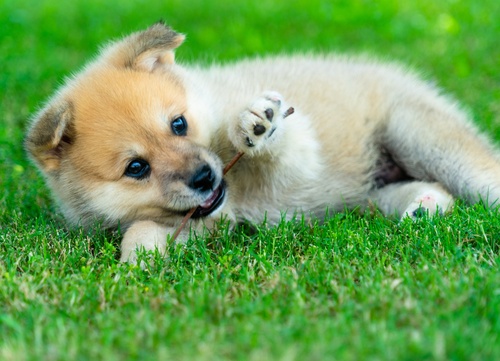
Discover all there is to know about the Pomsky: its characteristics, behavior, training, and its cost.
The Pomsky is a very recent dog breed that emerged about a decade ago in the United States. It is the result of a cross between a Husky and a Dwarf Spitz, also known as the Pomeranian. The Pomsky is not yet recognized as an official breed, but it has already achieved success! Its plush-like appearance and very affectionate nature make it a pleasant and cuddly companion. It is still difficult to define precise standards for this breed, but one thing is certain, it melts the heart of any dog lover!
This section outlines the unique features of the Pomsky breed.
The Pomsky is typically classified in the hybrid or designer dog group, combining traits from the Spitz (group 5) and Toy groups (group 9).
The Pomsky is a small to medium-sized breed. They generally range from 10 to 15 inches in height and weigh between 15 to 30 pounds.
They often inherit the thick, double coat of the Husky, which can range from medium to long in length.
Pomskies exhibit a wide range of coat colors that include gray, black, brown, and white, often with Husky-like markings.
Pomskies are adaptable to various living environments, thriving in both apartments and houses with yards. They require regular exercise and mental stimulation to stay happy and healthy.
They are generally friendly and sociable, enjoying the company of their human families. They can also coexist peacefully with other pets if properly socialized.
Pomskies are generally healthy, but like all breeds, they may be prone to certain genetic conditions. Regular veterinary check-ups are important to monitor their health.
The Pomsky is an intelligent and eager-to-please breed, making them relatively easy to train. Positive reinforcement and consistent training methods are essential for them
We can help!
Every dog has its own character, and so do you. Making the right choice will ensure his well-being and yours.
Take our quiz to find out which breed is right for you, based on your personality, lifestyle, location and many other criteria.
Don't wait any longer and take the quiz to find out the answer!
The Pomsky is a small to medium-sized breed, exuding the majestic aura of a Husky in a more compact form. Their plush coat is reminiscent of their Husky heritage.
The Pomsky does not have standard weight and size. It typically measures between 20 cm and 45 cm and weighs between 2 kg and 20 kg. There are three types of Pomsky sizes:
The growth of the Pomsky is quite rapid. Indeed, it reaches its adult size in its first year, between 10 and 12 months.
The Pomsky often sports a medium to long coat, reflecting its Husky heritage. The fur is thick and plush, providing a luxuriously soft feel. This double coat consists of a dense undercoat and a longer topcoat, which may exhibit a slight wave, adding to their distinctive appearance.
The Pomsky's coat color is one of its most captivating features, with a palette that typically mirrors the colors of its Siberian Husky parent. Common colors include shades of gray, black, and white, often adorned with Husky-like markings, including masks and capes.
The Pomsky's double coat requires regular grooming to maintain its beauty and health. They shed throughout the year, with increased shedding during the spring and autumn.
Regular brushing, at least a few times a week, is essential to manage shedding and prevent matting. Bathing should be done as needed, typically every few months, to keep their coat clean and healthy. It's important to use a gentle dog shampoo to protect their skin and enhance the coat's natural luster.
The Pomsky is among the cutest dogs! It has a rounded head, with two almond-shaped eyes that are either bright blue or heterochromatic, like the Siberian Husky.
At the top, it has two small pointed ears. Its body is quite dense, but harmonious and balanced. Its legs are thick, and its tail is bushy and long, usually curled.
The Pomsky is known for its playful, intelligent, and affectionate temperament. These dogs are adaptable, eager to please, and form strong bonds with their families.
There are hundreds of dog breeds worldwide, classified into various groups based on their characteristics and roles. The Pomsky, being a hybrid breed, isn't categorized in traditional breed groups but shares traits with both its parent breeds - the Siberian Husky and the Pomeranian.
The Siberian Husky, part of the group 5, is known for its endurance and intelligence, often used in sled pulling and other working roles. Pomeranians, from the toy group (group 9), are cherished for their lively and friendly nature. Pomskies inherit the best of both worlds - the work ethic and intelligence of the Husky and the sociable, affectionate nature of the Pomeranian.
The Pomsky is an engaging and spirited breed, known for its playful and outgoing demeanor. These dogs are highly affectionate and thrive on forming close bonds with their owners.
They often express their love through playful antics and cuddles, making them ideal companions for those who enjoy an active and affectionate pet. Pomskies appreciate having an attentive owner who can provide them with the interaction and mental stimulation they need for their well-being.
Pomskies are renowned for their sociable and generous nature. They generally get along well with humans, including both adults and children, making them suitable family pets. Their friendly disposition extends to other animals as well, although early socialization is key to fostering this trait.
Pomskies are particularly good companions for children, displaying patience and playfulness. Working on their social skills from a young age is important to ensure they grow into well-rounded and sociable adults, comfortable in various social situations.
Take the test and find out the dog breed that matches your personality and lifestyle.
The Pomsky is remarkably adaptable to various living environments, thriving in apartments, houses, and both urban and rural settings. However, they are active dogs and thus benefit from regular walks, ideally two outings per day, each lasting around 30 minutes to an hour, depending on their energy level.
While Pomskies can adapt to living indoors, they truly flourish when they have access to an outdoor space where they can explore and play. A secure garden or regular visits to a park provide an ideal setting for a Pomsky to exercise and satisfy its natural exploratory instincts.
The Pomsky is a breed known for its intelligence and eagerness to learn, making training a generally enjoyable experience. They are quick to pick up commands and enjoy mental challenges. Training should focus on positive reinforcement and consistency, as Pomskies respond well to rewards and praise.
Given their intelligence, it's also important to keep training sessions engaging and varied to hold their interest. Since Pomskies can be adventurous and may inherit the Husky's tendency to wander, equipping them with a GPS collar, like those offered by Weenect, can provide peace of mind against potential escapes or losses.
Pomskies often show excellent listening skills and a willingness to please their owners, which can make training more straightforward. They do have a playful and sometimes independent streak, so patience and understanding are key.
Training should be started early to establish good habits and socialization. Pomskies generally get along well with other pets and people, but early exposure to various environments and situations is beneficial for developing well-rounded social skills. With the right approach, a Pomsky can be a highly responsive and obedient companion.
Consistent daily care is crucial for maintaining their health, focusing on preventative measures to avoid diseases and infections.
Pomskies are generally healthy, but like all breeds, they can have specific health concerns. Some common predispositions include dental issues, similar to smaller breeds, and potential joint problems such as hip dysplasia, often seen in larger breeds like the Husky.
Eye conditions, such as cataracts, can also occur. It's important to be aware of these potential health issues and watch for any signs or symptoms. The typical lifespan of a Pomsky ranges from 12 to 15 years, depending on their overall health and care.
Regular veterinary care throughout a Pomsky's life is vital. This includes vaccinations, deworming, and parasite prevention as recommended by a veterinarian. Daily care is equally important and should include regular coat brushing to prevent matting, routine ear cleaning, dental care to prevent tartar buildup, and nail trimming.
Being aware of potential allergies and consulting with a vet for diet and care adjustments is also crucial. The Pomsky is not considered a hypoallergenic breed. Regular check-ups and attentive home care are key to ensuring a healthy, happy life for your Pomsky.
A diet rich in protein and essential vitamins is crucial for this active and intelligent breed. High-quality kibble, formulated for small to medium-sized breeds, provides a solid foundation for their daily dietary needs.
If additional protein is required, especially for more active Pomskies, supplementing their diet with lean red or white meats can be beneficial. However, it's important to keep fat intake in check to prevent weight gain and maintain overall health. Regular, measured feedings are recommended to manage their appetite and ensure they receive the right amount of food.
The Pomsky is a highly sought-after breed, adored for its unique appearance and endearing temperament. It's important to consider several factors before adopting.
Choosing a Pomsky requires careful consideration. It's crucial to select a reputable breeder, and visiting the breeder's premises is essential to assess the living conditions and behavior of the dogs. The health of the puppy and its parents is a primary concern; seek transparent information about their current health and any hereditary conditions.
Lastly, you must have your dog microchipped by the age of 8 weeks old and have their details registered on a relevant database like Petlog or Animal Tracker. This is a legal requirement in Great Britain, and you could face a
fine if you don't comply. Your vet can microchip your dog for a small fee, or any Blue Cross center will do it for free.
he cost of a Pomsky can vary based on factors such as lineage, pedigree, breeder reputation, and age of the dog.
Typically, Pomsky puppies can range in price from
to
. In addition to the initial cost, it's important to consider the ongoing expenses of owning a Pomsky, including veterinary care, food, and other supplies.
The annual cost of maintaining a Pomsky can be estimated at around
to
, depending on individual needs and circumstances.
Choosing a dog that matches your personality and lifestyle will ensure your well-being and his!
To access the most relevant information, suitable payment methods, and delivery in your region, please select the website corresponding to your country.
